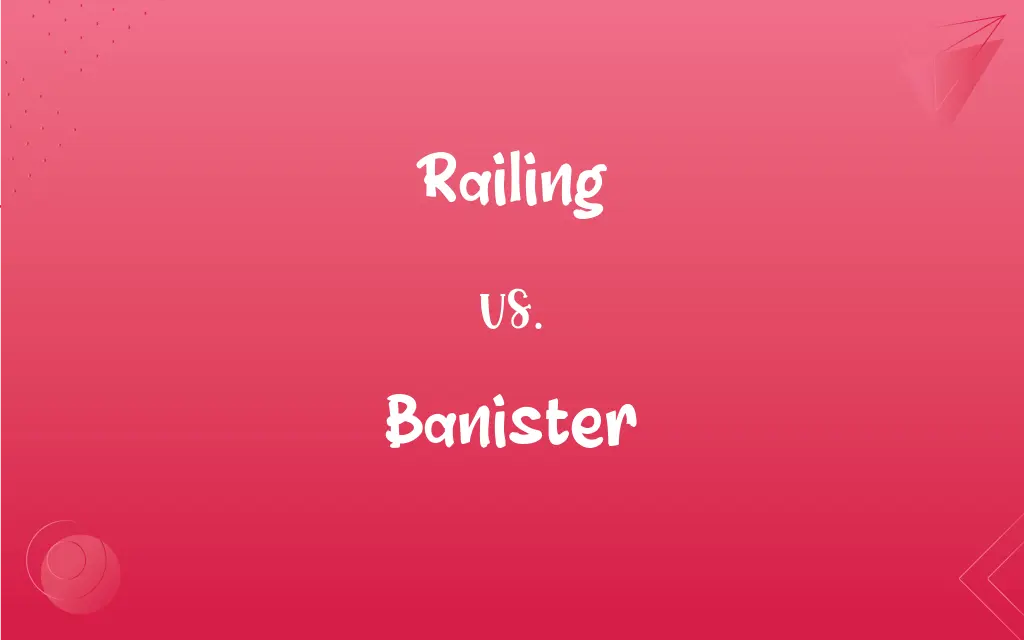Railing vs. Banister: What's the Difference?
Edited by Aimie Carlson || By Janet White || Updated on October 6, 2023
A railing is a fence-like barrier, often around platforms, while a banister specifically refers to the handrail on the side of a staircase.

Key Differences
Railings and banisters, while sometimes used interchangeably, have unique roles in architecture. A railing is essentially a barrier, often fence-like in structure, designed to keep people or objects within a particular boundary or from falling off an elevated area. Railings can be seen around decks, balconies, or alongside walkways. On the other hand, a banister serves specifically as a handrail on the side of a staircase. This implies its primary role is for grip and balance as one ascends or descends steps.
The term "railing" can be applied in various contexts, from the protective barriers alongside bridges to the metal or wooden structures enclosing a porch. They can be purely functional, ensuring safety, or they can have ornate designs contributing to the aesthetics of a space. Conversely, a banister's primary association is with stairs. It’s not just the handrail but also the vertical posts (called balusters) that support the handrail. Together, they ensure safety and provide support for those using the staircase.
When it comes to materials, both railings and banisters can be crafted from an array of materials including wood, metal, glass, or even stone. The choice often depends on the architectural style, functional requirements, and aesthetic preferences. For instance, a modern home might incorporate glass railings for a balcony to provide an unobstructed view, while a traditional wooden banister might be preferred for a classic, vintage staircase.
Railings, given their broader applications, can be found both indoors and outdoors. They can surround a loft inside a home, or they might line the edge of a commercial building's rooftop terrace. Banisters, by their specific nature, are predominantly an indoor feature, guiding individuals up and down interior staircases. However, they can occasionally be found outdoors if a staircase is part of an exterior structure.
From a linguistic standpoint, "banister" is often colloquially used in some regions to refer to the whole stair railing system, though purists would argue that it specifically denotes the handrail. "Railing," being a more generic term, finds its way into a wider range of descriptions without being tied to the context of stairs.
ADVERTISEMENT
Comparison Chart
Definition
A barrier for protection or demarcation.
A handrail for a staircase, often including balusters.
Usage
Can be found both indoors and outdoors.
Predominantly indoor, alongside staircases.
Material
Wood, metal, glass, stone, etc.
Wood, metal, sometimes combined with other materials.
Association
Platforms, walkways, decks, etc.
Staircases primarily.
Linguistic Use
Generic term for any protective or decorative barrier.
Often colloquially used for the entire stair railing system.
ADVERTISEMENT
Railing and Banister Definitions
Railing
A structure providing a handhold or support.
The hospital corridor had a railing to assist patients.
Banister
Colloquially, the entire stair railing system.
The child slid down the banister, laughing.
Railing
A barrier for protection or demarcation.
The deck had a wooden railing to ensure safety.
Banister
The handrail and its supporting posts on stairs.
The wooden banister had intricate carvings.
Railing
A decorative boundary in architecture.
The ornate railing added elegance to the mansion's balcony.
Banister
Often includes the vertical balusters supporting the handrail.
The banister's balusters were evenly spaced and painted white.
Railing
A barrier ensuring people or objects stay within bounds.
The walkway over the bridge had a metal railing.
Banister
A handrail for a staircase.
She gripped the banister as she descended the steep steps.
Railing
A fence-like structure around an elevated area.
The rooftop terrace was surrounded by a glass railing.
Banister
A handrail, especially on a staircase.
Railing
A structure made of a rail, often connecting a series of upright members, that is used as a guard or barrier or for support, as on a balcony or next to a staircase.
Banister
Such a handrail together with its supporting structures.
Railing
The rail of such a structure.
Banister
One of the vertical supports of a handrail; a baluster.
Railing
Rails considered as a group.
Banister
The handrail on the side of a staircase.
Railing
A fence or barrier consisting of one or more horizontal rails and vertical supports.
During the war, everyone's railings were taken away to make bombers.
Banister
One of the vertical supports of a handrail; a baluster.
Railing
Present participle of rail
Banister
To construct a banister
Railing
Expressing reproach; insulting.
Angels, which are greater in power and might, bring not railing accusation against them.
Banister
To act as a banister
Railing
A barrier made of a rail or of rails, together with vertical supports. The typical railing in the interior of structures or on porches has a horizontal rail near waist height, and multiple vertical supports. Its function is usually to provide a safety barrier at the edge of a verticle drop to prevent falls.
Banister
A baluster.
Railing
Rails in general; also, material for making rails.
Banister
The balustrade of a staircase. Formerly used in this sense mostly in the plural, now mostly in the singular.
He struggled to ascend the pulpit stairs, holding hard on the banisters. Sir W. Scott.
Railing
A barrier consisting of a horizontal bar and supports
Banister
A railing at the side of a staircase or balcony to prevent people from falling
Railing
Material for making rails or rails collectively
Banister
A structure providing grip and balance on stairs.
The spiral staircase had a smooth, curved banister.
FAQs
Are all stair railings called banisters?
Not all, but colloquially, many refer to the entire stair railing system as a banister.
Where can you commonly find a banister?
A banister is predominantly found alongside staircases, providing grip and support.
What is the primary purpose of a railing?
A railing serves as a protective barrier to ensure safety and demarcation.
Can a railing be made of glass?
Yes, glass railings are popular for modern designs, offering an unobstructed view.
Do all stairs need a banister?
For safety, it's recommended, especially for steep or long staircases.
Can railings be found outdoors?
Yes, railings can be found both indoors and outdoors, like around decks or walkways.
Can railings be decorative?
Yes, railings can be both functional and decorative, enhancing the aesthetics of a space.
Why might someone choose a metal banister over wood?
Material choice often depends on aesthetics, durability needs, and architectural style.
Is a banister the same as a baluster?
No, a banister refers to the handrail, while balusters are the vertical posts supporting the handrail.
Is the term "banister" exclusively American English?
While commonly used in American English, "banister" is understood in other English-speaking regions as well.
Is the primary role of a banister decorative?
While a banister can be decorative, its primary role is functional, providing grip and support on stairs.
Can a banister be a continuous piece without breaks?
Yes, some designs have continuous, flowing banisters without segmented balusters.
How are railings and banisters similar?
Both serve as barriers or supports, ensuring safety in their respective contexts.
Do railings only refer to elevated structures?
No, railings can be on the ground level, like around a property, or on elevated platforms.
Are railings mandatory on balconies?
For safety, most building codes require railings on elevated platforms, including balconies.
Can a banister exist without balusters?
While uncommon, some designs feature a handrail attached directly to the wall without separate balusters.
Can a banister be on just one side of a staircase?
Yes, some staircases have a banister on one side, especially if the other side is against a wall.
How do railings differ from fences?
While similar, railings often protect edges or openings, while fences usually enclose spaces.
Are railings and banisters only functional?
While primarily functional, both can be designed with decorative elements to enhance aesthetics.
Which term is broader in application, railing or banister?
Railing is broader, as it can apply to various barriers, while banister is specific to staircases.
About Author
Written by
Janet WhiteJanet White has been an esteemed writer and blogger for Difference Wiki. Holding a Master's degree in Science and Medical Journalism from the prestigious Boston University, she has consistently demonstrated her expertise and passion for her field. When she's not immersed in her work, Janet relishes her time exercising, delving into a good book, and cherishing moments with friends and family.
Edited by
Aimie CarlsonAimie Carlson, holding a master's degree in English literature, is a fervent English language enthusiast. She lends her writing talents to Difference Wiki, a prominent website that specializes in comparisons, offering readers insightful analyses that both captivate and inform.































































